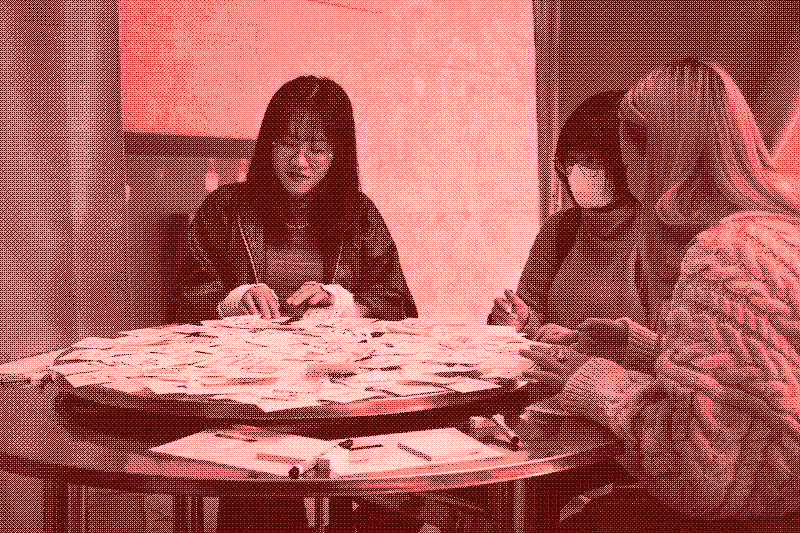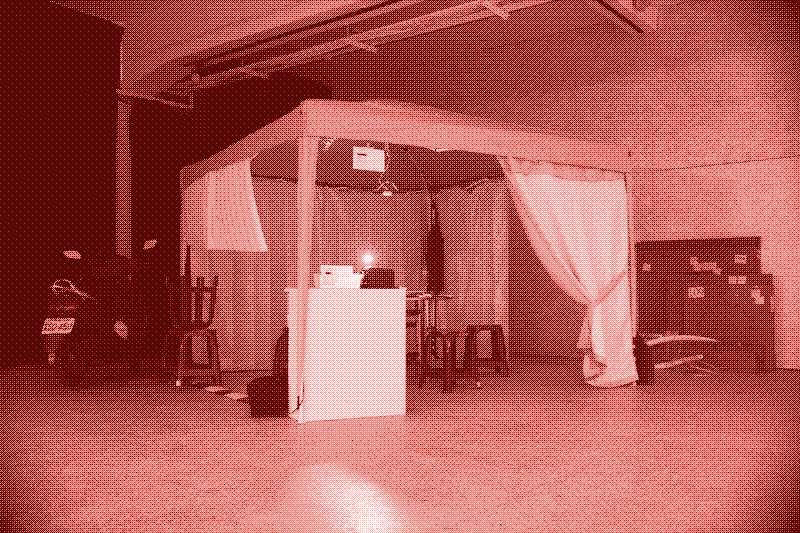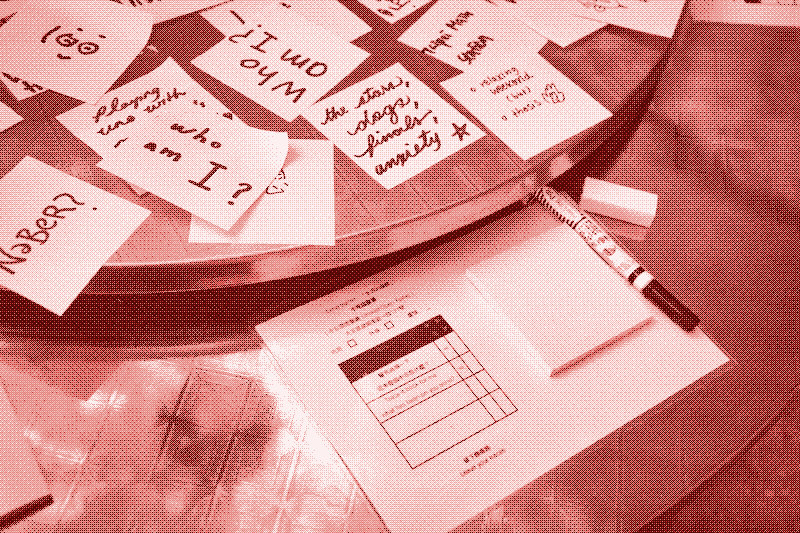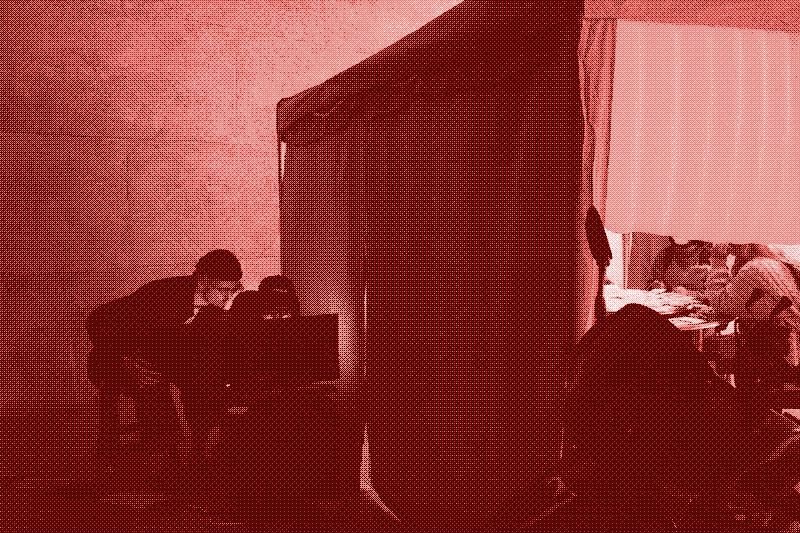in context of: Transcultural Collaboration 2023
mentors: Daniel Späti, Nuria Krämer, Dimitri de Pierrot
with: Esme Chuyi Wang, Martha Oelschläger, Leo Barton
exhibited at: C-Lab Taipei (Taipei Contemporary Culture Center)

a view of visitors inside the installation
abstract
Surrounded by traces.
Regardless if their origins are internal or external, all of these traces are deeply tied to the traces of others. In turn forming a collective system of memory, which exerts influence on groups and individuals, often in unforeseen ways.
Which traces are yours?
Where do they connect?
At its base, whether active or passive, constructive or destructive, loud or quiet, present or past, all members of the collective contribute to this larger system of memory.
Adopting the form of a Taiwanese night-market stall, – living traces – hosts a space to replicate such a system, on a small scale. The audience is invited to leave traces and engage as much as they feel comfortable with.
我們被痕跡所圍繞。
無論源於自身或外界,所有我們的痕跡都深深聯繫於他人的痕跡。而由此形成的集體的記憶系統,則通常以無法預知的方式,對集體和個體產生影響。
哪些痕跡是從你而來?
它們又連接向了哪裡?
根本上,無論主動或被動、建設性或毀滅性、響亮或安靜、源自當下或曾經,所有處於集體中的分子,都成為建立這個更大的記憶系統的一部分。
「生活的痕跡」復刻台灣夜市攤位的形式和系統,建立了一個小型的空間,並邀請觀眾留下痕跡,在舒適範圍內最大限度地參與其中。
description

a front view of the installation
借用台灣標誌性的夜市攤位的形式,觀眾緩緩發現「生活的痕跡」其中的各種媒介和體驗。首先,觀眾將遇到一個涼亭攤位,米色窗簾後若隱若現的內容令人好奇。行入攤位之中,鋁製檯面上擺著轉盤,而紅色塑料凳將整台桌環繞,邀請觀眾入座。
Taking the form of an iconic Taiwanese night-market stall, the audience slowly discovers the various media and
experiences to be had within –living traces –.
First, the viewer will encounter the curtained beige pavilion, partially hiding its content and evoking curiosity.
Stepping in, the circular aluminium table and lazy Susan surrounded by red plastic stools invites visitors to sit.
檯面已然擺放整齊,然而其中卻沒有餐具或食物。便簽紙和筆擺放在各個客人的菜單之前,令人思考的提問而非食物印在菜單上,令每一個座位生 色。檯面中央的轉盤被觀眾寫滿答案的便簽紙覆蓋。觀者在菜單上的開放式問題之中徘徊,應邀將他們的痕跡添加到轉盤上的收藏之中。
The table is set. However, there is no cutlery or food here. Sticky notes and pens adorn each place
alongside a laminated menu, featuring questions instead of foods. Written notes cover the turntable in the centre. With a wandering look between the open-ended questions on the menu, visitors are invited to add their traces to those collected on the turntable.
當好奇的目光離開桌子時,觀眾發現了照亮攤位天花板的投影。轉盤上的文字和符號在緩慢排列組合,逐漸連結成為點點相連的雲。

the table setting

view of the projection on the roof
As the curious gaze detaches from the table, the audience discover projections illuminating the ceiling of the pavilion. Words and symbols from the turntable become a cloud of interconnected points in a slow choreography of moving links.
在離開的時候,觀眾會經過一個小櫃檯,那裡有一台收據機,邀請人們「結帳」。 按下按鈕即可列 印收據,向觀眾獻上可以隨身攜帶的,這街邊 攤位桌邊小聚的痕跡。
When time comes to leave the audience pass a small counter, where a receipt machine invites to “check out“. At the push of a button, a receipt is printed. Offering the audience to take the collated traces of the table with them.
Surrounded by traces. Whether their origins are internal or external, all of these traces are deeply tied to the traces of others. In turn forming a collective system of memory, which exerts influence on groups and individuals, often in unforeseen ways. Within the space, visitors are invited to introspect, connect and leave traces, engaging as much as they would like. Whether active or passive, constructive or destructive, loud or quiet, present or past, all members of the collective contribute to this larger system of memory.
我們被痕跡所圍繞。無論源於自身或外界,所有我們的痕跡都深深聯繫於他人的痕跡。而由此形成的集體的記憶系統,則通常以無法預知的方式,對集體和個體產生影響。在這個空間裡,參觀者被邀請反思、連結、留下痕跡,盡可能地參與其中。無論主動或被動、建設性或毀滅性、響亮或安靜、源自當下或曾經,所有處於集體中的分子,都為這個更大的記憶系統做出了貢獻。
impressions

the check-out counter after a while

a view behind the curtains